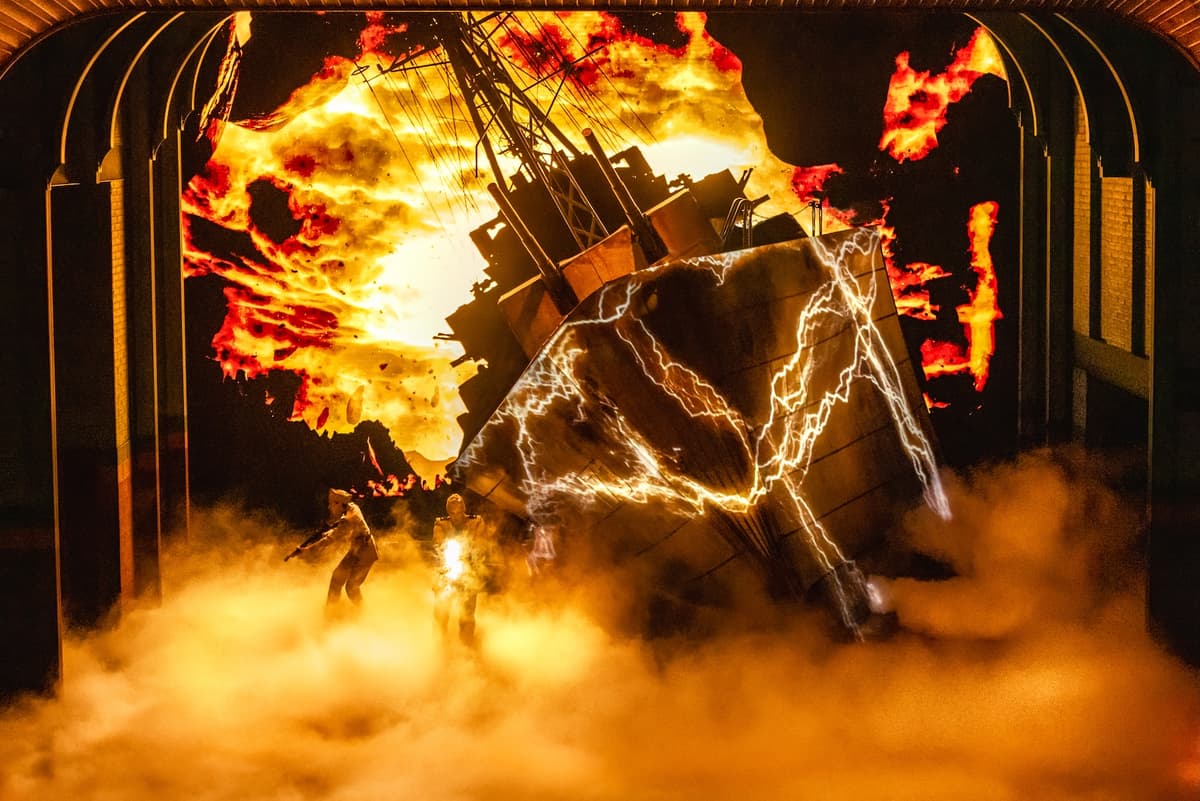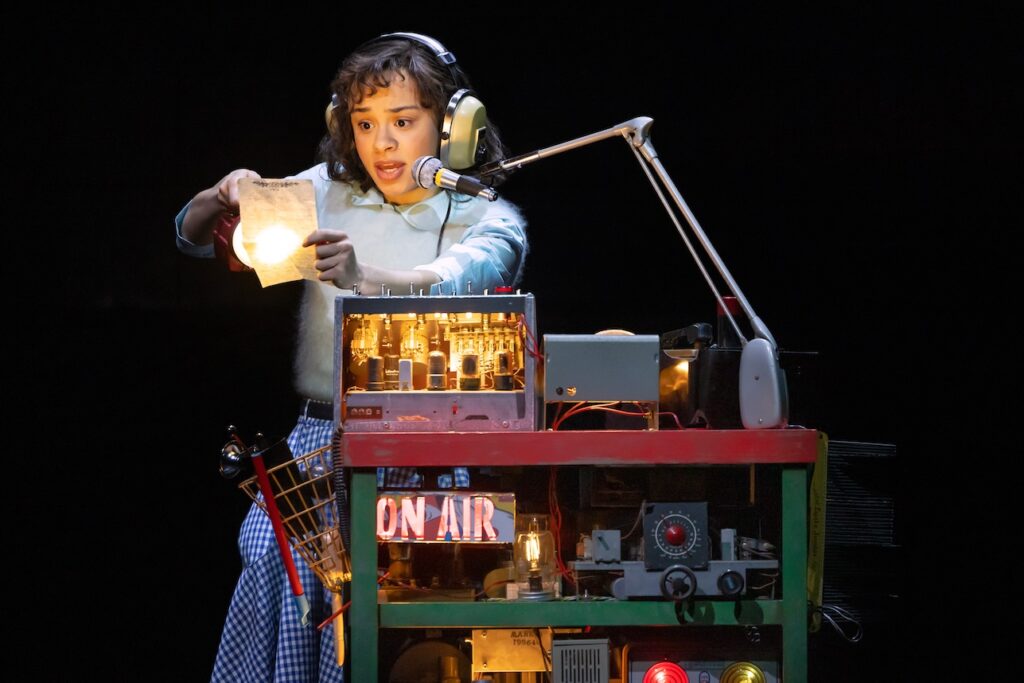A Cleverly Constructed Story and a Vibrant Young Cast Add Substance to the Special Effects-Laden ‘Stranger Things: The First Shadow’
Anyone who is pregnant, prone to seizures, or just irritated by recurring, sometimes sudden bursts of loud noise and louder visual effects should be warned: The new play based on the Netflix series can be something of a sensory assault.

For a brief but terrifying moment in the opening scene of “Stranger Things: The First Shadow,” a new play based on the popular Netflix series, audience members may fear they’re in store for a prolonged sensory assault along the lines of “Back to the Future: The Musical,” the theme park attraction disguised as a musical comedy that hit Broadway like a tornado nearly two years ago.
Mind you, “First Shadow” isn’t a musical — though there are flashes of song and dance — and as anyone familiar with the series would guess, it dwells in much darker sci-fi terrain than that 1985 film hit starring Michael J. Fox. The scene just described recreates an episode known in paranormal lore as the Philadelphia Experiment, or Project Rainbow, in which the United States Navy supposedly sought to make a destroyer invisible to enemy radar during World War II.
According to varying accounts, the ship vanished but then reappeared; in the process, crew members died, went insane, became mysteriously ill, and even found their bodies fused to the vessel. These reports, though denied by the military, have continued to fuel conspiracy theories accusing the government of other shady operations — among them the Montauk Project, an alleged extension of Rainbow that informed “Stranger Things,” involving the Air Force, time travel, teleportation, extraterrestrial beings, and mind control.
That’s a lot of background, I realize, but it may help prepare you for “First Shadow,” which begins with a droll exchange between a naval captain and his privates that is quickly interrupted by a blinding, cacophonous blizzard of special effects, abetted by Jon Clark’s lighting and Paul Arditti’s sound design. Creatures called Demogorgons, known to fans of “Stranger Things” as bloodthirsty monsters from another dimension, are also involved.

Anyone who is pregnant, prone to seizures, or just irritated by recurring, sometimes sudden bursts of loud noise and louder visual effects (the latter by Jamie Harrison and Chris Fisher, who provide illusions, and 59, a studio that also manages video) should be warned that the scene is not an anomaly. Yet unlike that musical adaptation of “Future,” “First Shadow” also offers substance, in the form of a cleverly constructed story that director Stephen Daldry and his vibrant young cast make compelling even for those of us who haven’t watched “Stranger Things” faithfully, or at all.
If this new play invites comparisons to any other Broadway outing, in fact, it’s “Harry Potter and the Cursed Child.” Written by Kate Trefry, also a writer and co-executive producer of the series, “First Shadow” also arrives at New York following a successful London debut. Ms. Trefry’s script is drawn from an original story she crafted with the Duffer Brothers, who created the series, and Jack Thorne, the British playwright and screenwriter who penned “Cursed Child” — based on an original story he had written with J.K. Rowling and John Tiffany.
Where “Cursed Child” follows Ms. Rowling’s boy wizard and his cohorts nearly two decades after the last book of her original series leaves off, introducing us to their children, “First Shadow” is a prequel, presenting some of the adult characters in “Stranger Things” during their teenage years and fleshing out others who didn’t figure as prominently in the series.
There’s also a new character, Patty Newby, the adopted daughter of Hawkins High School’s principal. In the series, set in the 1980s, we meet the principal’s son, Bob, as a grownup who dates Joyce Byers, his former classmate. In “First Shadow,” which unfolds in 1959 and 1960, a young Joyce Maldonado (her maiden name, presumably) is the feisty director of the school’s drama club production; in lieu of “Oklahoma!,” Joyce plans to entertain her sleepy Indiana town with something called “The Dark of the Moon,” which “isn’t just a play,” she declares: “This is a revolution.”
That disruptive spirit comes in handy when beloved pet animals start dying grotesquely, and Joyce teams up with Bob and James Hopper Jr. — the local police chief in “Stranger Things,” here the police chief’s son — to solve the murders, which seem to coincide with explosions of radio static. It turns out that a new kid in town named Henry Creel, whose family moved after an ugly experience at another school, carries a radio with him everywhere, and has a curious and unsettling relationship with the object.
Henry, whose name will send shivers down the spine of “Stranger Things” diehards, happens to be the son of an Air Force vet who survived a deadly incident. The boy, sweetly played by Louis McCartney — the actor paces the stage intermittently as his character tries to reassure himself: “I’m normal” — forms a fast bond with Patty, who also feels like an outsider but seems a bit surer of herself, as conveyed in Gabrielle Nevaeh’s plucky performance.
As presented in the play, Henry and, to some extent, Patty can suggest another major character in the series who’s only mentioned briefly here, as Ms. Trefry deftly juggles the melodrama intrinsic to her own story with playful, sometimes bawdy humor. It’s all well served by Mr. Daldry, a celebrated veteran of film, Broadway, and the West End, and his gung-ho actors; Alison Jaye’s comically intense Joyce and Burke Swanson’s James Jr., at once drier and goofier, are especially fun to watch as they lay a giddy foundation for the romantic tension their characters will carry into adulthood.
We also meet one Dr. Brenner, another name bound to chill devotees of the series, played here by Alex Breaux, whose suitably creepy unctuousness in the role is enhanced by the actor’s resemblance to Tony Robbins, the controversial motivational speaker. But that’s a horror story for another time; suffice it to say this new one will hold your attention — aggressively at times — regardless of your familiarity with the source material.

